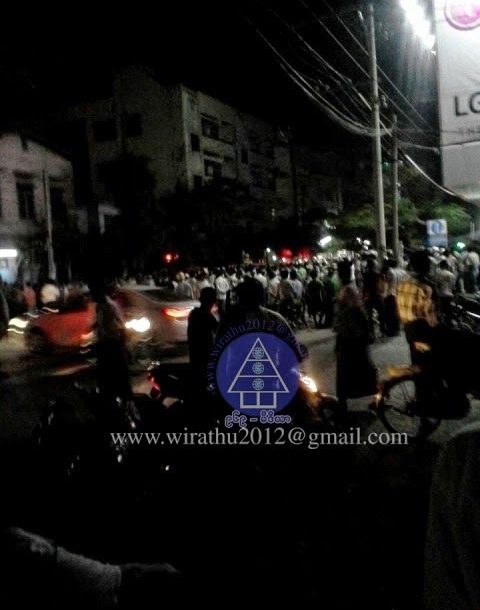On Wednesday morning reports began to surface of serious unrest and mob behavior overnight in Mandalay. One blog report in particular demonstrates the dangerous nature of conjecture and rumour, and their role in the violence.
The post reports that “two notorious Muslim brothers widely known as the Mandalay-Mafia kidnapping and violently raping a Burmese-Buddhist girl who works for them”. The brothers are further indicted as “wealthy Bengali-Muslim brothers who own a string of teashops and restaurants in Mandalay City as a cover for their illicit drug trafficking operations”.
The website reports enough geographic details, quantifies crowd numbers and dates to give the report a veneer of authority. Reporting that the rape of the young girl occurred on 30 June 2014 on the road to Naypyitaw, where the young girl was “pushed out” on the roadside and found by police officers at the traffic lights near Myinyadanar Ward in Pyinmana. Police then started searching for the “two Muslim brother rapists who were now hiding in their home-base Mandalay City”.
On their return to Mandalay, “more than a thousand Buddhist crowd led by monks gathered at their flagship teashop Sun-Café at the intersection of 82nd Street and 28th Street and demanded justice”. Monks demanding justice, this gives the crowd the moral high ground, but both monks and morally charged language like “justice” have been constantly deployed in Myanmar’s recent communal violence to devastating effect.
The chronology of the article is confused. First it is reported that the Buddhist crowd gathered and were met by “a large group of Mandalay Muslims worrying about the severe impact on their businesses and their lives were already gathering at the Sun-Café to demand the Muslim-Mafia brothers behave or they themselves would kill their fellow Muslims”. Implying the Muslims are now turning against themselves and cannot even control one another.
Later in the article it is claimed that the groups outside Sun-Café were actually a group of 500 “Bengali-Muslims” who were quarreling amongst themselves, with one side allegedly there to “protect their Muslim brothers” and the other side to “drive the bad Muslim-Mafia out of town”. The facts are not important to this article, nor to many others. What is important is the cautionary tale: that Muslims are raping Buddhist women, and Muslims are threatening Buddhists’ livelihoods and safety.
And to draw some final ethnically charged symbolism into the event: “Two Buddhist were reportedly killed by Muslim sword while a few policemen were also badly injured”. Again, the onus is placed on the Muslim instigators: they are killing Buddhists and injuring the peace-keeping police.
As yet, it is unclear if even the basic details are true. Aside from that reported by blogs that are known to be inflammatory and U Wirathu himself, there seems to no authority giving credence to the story of the girl in the police station. Where is the police statement? The tea shop owners’ family claim they never even had a maid. At best this creates conflicting narratives that reinforce pre-existing biases.
And if the basic details are true, the framing of the incident within days by the blog and U Wirathu clearly highlights a series of pre-existing grievances and stereotypes about Muslims frequently deployed in the ongoing religious tensions. The symbol of the maid and the white luxury sedan are two — they appear as banal facts but when put in the context of Muslim, and particularly the idea of a “mafia” and links to drug trafficking, they speak directly to concerns about wealth inequality. Muslims are rich and can afford such luxuries, it suggests, but they are also nefarious and amoral — always searching for a fight.
This blog post and other Burmese commentary are tragic demonstrations of some endemic problems in Myanmar’s information culture. The role of rumour and conjecture in the Mandalay conflict cannot be overlooked, and those promulgating such rumours are responsible for a significant amount of Myanmar’s current unrest.
 Facebook
Facebook  Twitter
Twitter  Soundcloud
Soundcloud  Youtube
Youtube  Rss
Rss 